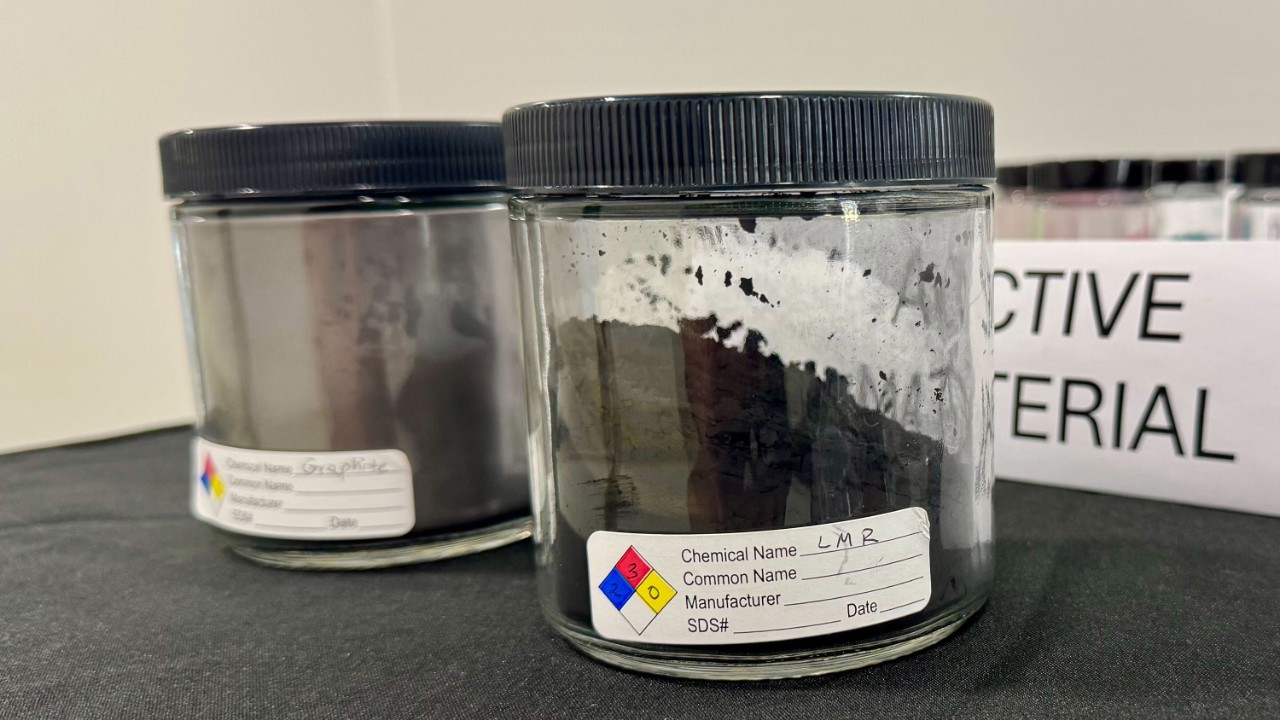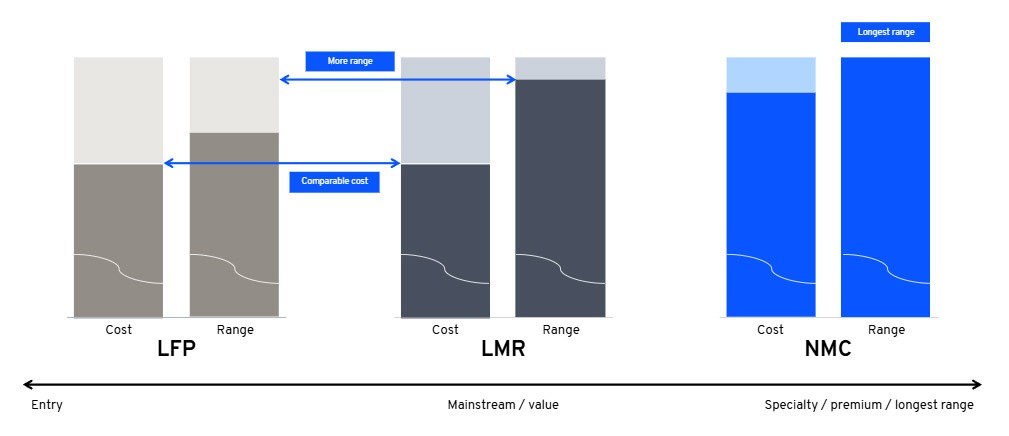Plugged In: Choose your own battery chemistry adventure
2025-07-29
By Mandira Ganti, intern, Tech Communications
With summer adventures underway, many people are gearing up for hiking trips. And believe it or not, packing the perfect backpack for your trip is a great way to think about EV battery chemistry.
Just like hikers decide which gear and pack will match their budget and travel needs, automakers make similar choices with battery chemistries based on vehicle and customer needs. Following our recent battery cell manufacturing announcements, we thought it was the perfect time for a quick tech explainer. Let’s break down the three battery chemistries in GM’s roadmap through the lens of backpacking.
Cathodes 101
Let’s start with a few basics about batteries. The cathode is the positive electrode in a battery cell and the anode is the negative electrode. With lithium stored in each electrode, electricity is generated by the battery when lithium ions and electrons move between them.
Just like what you pack determines how far and how comfortably you can hike, the materials in a battery cathode help determine how far an EV can go and how much it costs. Most anodes are made of graphite (like pencil lead), but cathodes are where things get interesting — they’re packed with combinations of nickel, manganese, cobalt, iron, and phosphate, each adding different traits to the battery’s performance.
GM today is focused on three primary battery chemistries: NMC, or Nickel Manganese Cobalt; LFP, or lithium iron phosphate, and LMR, or Lithium Manganese Rich. The three offer different levels in cost, durability, and performance.
A deeper dive
Let’s take a closer look at these three battery chemistries.
NMC (Nickel Manganese Cobalt): The luxury camping chemistry
Think of NMC as a high-performance backpack: built for long, demanding adventures. Nickel and cobalt are the priciest materials in EV batteries, but they deliver smooth, powerful performance. It costs more but unlocks high-end capabilities and cutting-edge features. That’s why NMC is the go-to choice for premium vehicles with top-tier performance.
LFP (Lithium Iron Phosphate): The day hike chemistry
LFP is like a simple, sturdy backpack built for a casual day hike — reliable, durable, affordable, and always ready to go. Thanks to its long track record, LFP is well-suited for a variety of vehicles and driving needs. It gets the job done and has been implemented in EVs for years, so it’s ideal for everyday drivers and cost-conscious adventures alike.
LMR (Lithium Manganese Rich): The group trip chemistry
LMR is more like an innovative new backpack design using cost-effective materials — spacious, affordable, and purpose-built for bigger trips. Using chemistry breakthroughs, it delivers significantly more range than LFP at a similar cost, and its initial entry into the market has been custom designed to be an ideal fit for full-size trucks and SUVs. It’s a smart choice when you need room to haul more, go farther, and do it efficiently — much like a roomy backpack that you and your whole group can depend on.
Choosing the right battery for an EV is a lot like picking the right backpack for a hike — it depends on where you’re going, how far and what you need to carry. The better the match, the better the experience. That’s why GM plans to employ all three types of batteries in our lineup: to make sure every vehicle is equipped for its unique journey. Meanwhile, GM will continue to explore other new battery technologies — writing the packing list for new batteries, one element at a time.
An EV battery cell's "secret sauce" is mixed into a powder to create active materials, which are then mixed into a slurry ready for coating the cell's anode.
With summer adventures underway, many people are gearing up for hiking trips. And believe it or not, packing the perfect backpack for your trip is a great way to think about EV battery chemistry.
Just like hikers decide which gear and pack will match their budget and travel needs, automakers make similar choices with battery chemistries based on vehicle and customer needs. Following our recent battery cell manufacturing announcements, we thought it was the perfect time for a quick tech explainer. Let’s break down the three battery chemistries in GM’s roadmap through the lens of backpacking.
Cathodes 101
Let’s start with a few basics about batteries. The cathode is the positive electrode in a battery cell and the anode is the negative electrode. With lithium stored in each electrode, electricity is generated by the battery when lithium ions and electrons move between them.
Just like what you pack determines how far and how comfortably you can hike, the materials in a battery cathode help determine how far an EV can go and how much it costs. Most anodes are made of graphite (like pencil lead), but cathodes are where things get interesting — they’re packed with combinations of nickel, manganese, cobalt, iron, and phosphate, each adding different traits to the battery’s performance.
GM today is focused on three primary battery chemistries: NMC, or Nickel Manganese Cobalt; LFP, or lithium iron phosphate, and LMR, or Lithium Manganese Rich. The three offer different levels in cost, durability, and performance.
A deeper dive
Let’s take a closer look at these three battery chemistries.
NMC (Nickel Manganese Cobalt): The luxury camping chemistry
Think of NMC as a high-performance backpack: built for long, demanding adventures. Nickel and cobalt are the priciest materials in EV batteries, but they deliver smooth, powerful performance. It costs more but unlocks high-end capabilities and cutting-edge features. That’s why NMC is the go-to choice for premium vehicles with top-tier performance.
LFP (Lithium Iron Phosphate): The day hike chemistry
LFP is like a simple, sturdy backpack built for a casual day hike — reliable, durable, affordable, and always ready to go. Thanks to its long track record, LFP is well-suited for a variety of vehicles and driving needs. It gets the job done and has been implemented in EVs for years, so it’s ideal for everyday drivers and cost-conscious adventures alike.
LMR (Lithium Manganese Rich): The group trip chemistry
LMR is more like an innovative new backpack design using cost-effective materials — spacious, affordable, and purpose-built for bigger trips. Using chemistry breakthroughs, it delivers significantly more range than LFP at a similar cost, and its initial entry into the market has been custom designed to be an ideal fit for full-size trucks and SUVs. It’s a smart choice when you need room to haul more, go farther, and do it efficiently — much like a roomy backpack that you and your whole group can depend on.
Choosing the right battery for an EV is a lot like picking the right backpack for a hike — it depends on where you’re going, how far and what you need to carry. The better the match, the better the experience. That’s why GM plans to employ all three types of batteries in our lineup: to make sure every vehicle is equipped for its unique journey. Meanwhile, GM will continue to explore other new battery technologies — writing the packing list for new batteries, one element at a time.

